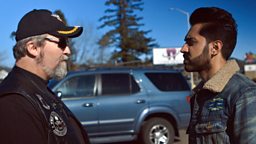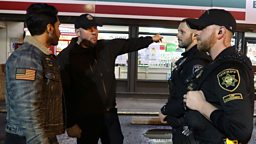Mobeen Azhar on why the murder of Larnell Bruce is part of a broader story about race in America today

In his brand new two-part series for 主播大秀 Two - A Black And White Killing: The Case That Shook America - Bafta Award-winning journalist and presenter Mobeen Azhar travels to Oregon to follow the trial of Russell Courtier, a member of white supremacist gang European Kindred, who ran over and killed Larnell Bruce, a young black man, with his car.
Here, Mobeen talks about what he discovered while making the series, and the long-term significance of the case in America today.
Why did you make this series?
I began working on the series in Portland in August 2018. I wanted to understand the circumstances of the murder of Larnell Bruce, a young black man who was killed by a white supremacist gang member. The more time I spent in Portland, the clearer it became that the case was part of a much bigger story about race, white supremacy and racial tensions in America today.
This August marks two years since the Unite the Right white supremacist rally in Charlottesville
In search of answers I sat in on the trial, whilst, outside the court I came face-to-face with members of white supremacist gangs, neo-Nazis and armed white men who seem to be threatened by a liberal agenda.
I also spent time inside prison to explore how racial segregation plays a part in the creation of white supremacist gangs like Europe Kindred.
I think it’s also important to remember that this August marks two years since the Unite the Right white supremacist rally in Charlottesville. We all saw the violence that poured out of that event and I could feel that in recent years the conversation around race in America had shifted.

Why is the case of Russell Courtier so important?
The State v. Russell Courtier is a case that many in Portland and the rest of America followed closely. Two men had a fight outside a convenience store. When the fight was over, Russell Courtier, a white man, got into his car, put his foot on the accelerator and struck down Larnell Bruce, a black man, who later died. It turned out that the white man was a member of a white supremacist gang.
The events of that night aren鈥檛 disputed but Courtier鈥檚 motivation was and the jury had to decide if Bruce was killed because he was black
The events of that night aren’t disputed but Courtier’s motivation was and the jury had to decide if Bruce was killed because he was black. The family of Larnell Bruce told me they desperately wanted Courtier’s motivation to be acknowledged by a court of law. Set against a backdrop of racial tensions the verdict would be hugely significant in today’s America.
I’ve always thought of Portland as a liberal city but this case brought some disturbing facts to the surface. Across the city I saw billboards, paid for by campaign groups, that referenced the number of white supremacist groups in Portland and Oregon’s white supremacist history. I found out Oregon was once a white-only ethno-state and that in the 1920s it had more Ku Klux Klan members per head than anywhere else.

What does this case say about America?
The killing of Larnell Bruce didn’t happen in isolation. There are economic factors at play, like poverty and lack of opportunity, which can drive violent crime. Larnell was staying in an area with extreme poverty and high rates of gang violence and the killing took place in a place notorious for violent crime.
What happens when men who have joined a gang in a racially-segregated prison system are released back into society?
Secondly, almost all the men I met who were, or had been, part of a white supremacist gang had come from instability and said they had joined the gang for protection. Russell Courtier joined the European Kindred gang whilst in prison years before the killing of Larnell Bruce.
Professor Randy Blazak, who has studied prison gangs, explained that the protection they offer in prison comes at a price. There is a system of ‘blood in’ and ‘blood out’ which means anyone who wants to join or leave the gang must hurt or even kill someone.
So what happens when men who have joined a gang in a racially-segregated prison system are released back into society? I believe this has profound implications for America.
You delve deep into the heart of America’s far right - what shocked you the most during your investigation?
It’s disturbing to spend time with people who see racist language or racially motivated violence as a reasonable option, but I wanted to understand their motivation.
There鈥檚 a tangible sense of a divided society. I鈥檝e never felt that so acutely when working in America before
What I found more shocking is that there are commonalities amongst those who are engaged in far right activity. I spent time with active gang members, those who had committed extreme acts of violence as well as armed campaigners who say they are simply ‘patriots’. Regardless of age, gender or affiliation, these people generally shared a sense of victimhood. I met a man who mounts swastikas and slogans about ‘white genocide’ on a mobile billboard truck who lamented his ‘silencing’ by liberals. A member of the group Patriots Prayer said he is not racist and went on to explain how it’s hard to be a white straight man in America today. In his words: “You have to say bad things about white people or you will be ostracised.” He also told me men in Portland "pretend to be gay", just to fit in.
This is happening in America today. Everyone has an opinion and many people feel they have to pick a side. There’s a tangible sense of a divided society. I’ve never felt that so acutely when working in America before.

You go behind bars to speak to members of white supremacist gangs. Can you tell us a bit more about the experience?
Hearing the clank of prison gates and spending time inside a cell is unnerving in any context. On this occasion I wasn’t sure how I’d be received by men who were serving long sentences (in some cases life) for committing extreme acts of violence in the name of white supremacy.
Anything that allows us to understand why someone becomes a member of a white supremacist gang and how they can leave it behind, is valuable
I visited a prison called Airway Heights. It’s different to most prisons as it’s recognised as a safe space for gang members who want to leave their gang. This can be a life threatening decision, but at the prison I visited there is a degree of protection and rehabilitation.
Many of the men I met had associated exclusively with people of their own race for years on end. I wasn’t sure how these men would relate to me and if they would even answer my questions. Overwhelmingly, I felt privileged to be able to have the conversations I did. Anything that allows us to understand why someone becomes a member of a white supremacist gang and how they can leave it behind, is valuable, in my opinion.
The first episode of A Black and White Killing: The Case That Shook America airs on Sunday 25th August at 9pm, 主播大秀 Two or you can catch up soon after on 主播大秀 iPlayer.
